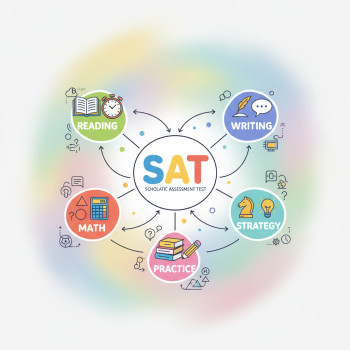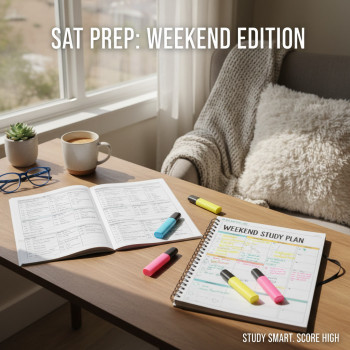Why this balance matters: scores, stories, and the human side of admissions
When you picture a college application, two things often fight for attention: the numbers and the narrative. On one side you have the SAT score — a crisp, comparable number colleges can slot into spreadsheets. On the other side you have essays — messy, human, and impossible to boil down to a single percent. The smart work is not choosing one over the other but learning how to make them complement each other.
This article is written for students standing at the center of this tug-of-war and for the parents who want to support them without turning the process into a stress marathon. You’ll get practical strategies, examples, and a clear timeline to help you allocate time, energy, and emotion so both your SAT performance and your writing shine.
First principles: what colleges actually look for
Admissions officers see thousands of applications. What stands out? Consistency, potential, and evidence of curiosity or persistence. A great SAT score can open doors, but essays show who you are inside those doors. High scores tell colleges you can handle academic rigor; essays tell admissions officers whether you’re likely to contribute to campus life, persist through challenges, and make the most of the opportunity.
Three takeaways to hold onto:
- Neither scores nor essays act alone; they speak together.
- Different colleges weigh each element differently — conservative use of both is smart.
- Your aim should be coherence: your academic record, test scores, and personal writing should tell a consistent story.
How the Digital SAT changes the equation (short, practical note)
The digital SAT shifted test-day logistics and timing, and it emphasizes adaptive question sets and a streamlined testing app. While the format can feel different, the core outcome remains: a standardized signal of academic readiness. In short, treat the digital SAT as an opportunity to optimize strategy and time-saving techniques on test day so you can free up energy for essays during the application season.

Where to invest time: a simple priority framework
Think of your effort like an investment portfolio. You should balance ‘growth’ (improving test scores) with ‘brand building’ (essays and extracurricular storytelling). Here’s a practical framework:
- Baseline readiness: If your current SAT score puts you far below the median for your target schools, prioritize test prep until you reach or exceed that median.
- Return on effort: If small investments in writing or editing could meaningfully raise the quality of your essays, invest there — essays are often low-cost, high-return.
- Holistic fit: If your extracurriculars and recommendations already tell a strong story, a modest SAT bump may be enough; if not, focus on the essays.
Quick checklist: When to prioritize tests vs essays
- Prioritize tests if: your score is more than one standard deviation below the target school’s median, or you’re applying to test-required programs (e.g., certain merit scholarships or specific STEM programs).
- Prioritize essays if: you have a compelling story that’s underrepresented by your transcript, or you’re applying to test-optional colleges that emphasize essays.
- Parallel path (best-case): allocate weekly blocks to both — see the sample schedule below.
Sample weekly schedule: balance without burnout
Here’s a realistic 12-week micro-cycle that keeps both test prep and essay work moving forward. Adjust intensity depending on your baseline and deadlines.
| Weeks | SAT focus (hours/week) | Essay focus (hours/week) | Goal |
|---|---|---|---|
| 1–4 | 6–8 | 4–6 | Build strategy and drafts |
| 5–8 | 8–10 | 3–5 | Score improvement & essay revisions |
| 9–11 | 6–8 | 6–8 | Final practice test; polish essays |
| 12 (buffer) | 2–4 | 4–6 | Final edits, rest, and logistics |
This schedule assumes you’re balancing school, activities, and applications. The buffer week is vital: rest matters for sharp performance on test day and when writing polished essays.
Practical strategies for improving SAT scores efficiently
You don’t need to double your prep time to see gains. Instead, be strategic:
- Use diagnostic tests to find the three question types that cost you the most time or points. Focused mastery beats scattershot practice.
- Master the test interface and timing of the digital format. Familiarity reduces stress and avoids careless mistakes.
- Practice with full timed sections to build stamina. Tilt one practice day a week toward a full-length practice test.
- Review incorrect answers thoroughly: write down why you missed a question and what rule solves it.
- Use targeted drills for weak areas — a short, focused session beats a long, unfocused one.
Small adjustments — refining pacing, learning a couple of grammar rules, or mastering the most common algebra patterns — often produce outsized score boosts.
Practical strategies for essays that resonate
College essays are not long-term diaries. They are tightly edited arguments demonstrating growth, perspective, or authentic passion. Follow this approach:
- Start with a clear moment: open with a small, specific scene or detail that anchors the reader.
- Focus on reflection: the story should lead to insight. What did you learn or how did you change?
- Show — don’t summarize: use sensory detail and action to reveal character rather than telling admissions officers what you want them to think.
- Edit for voice and clarity: read essays aloud, cut passive phrasing, and remove anything that sounds like a résumé bullet.
- Get selective feedback: ask trusted teachers, advisors, or tutors for one deep round of feedback rather than many shallow rounds.

How to make SAT prep and essay writing support each other
Rather than seeing SAT prep and essay writing as competing tasks, intentionally design them to feed one another.
- Critical reading practice for the SAT directly improves essay analysis and vocabulary choices.
- Timed writing drills (brief, focused) sharpen clarity and economy — both useful for essays and for SAT Writing & Language questions.
- Use mistakes as material: a persistent weakness in evidence interpretation on the SAT could inspire an essay that shows how you learned to evaluate sources or think critically.
Example cross-training:
If you struggle with inference questions on reading sections, spend a week reading short op-eds and writing 200-word reflections. That practice builds the habit of extracting main arguments quickly — useful for both tests and essays.
When to mention your SAT score in your application strategy
Most colleges allow you to choose whether to send SAT scores. This choice matters. Consider these rules of thumb:
- Send scores when they support your academic profile. If your SAT is at or above the median for admitted students, it strengthens your file.
- Don’t stress about a single practice test. Use official score reports and official practice results to guide decisions.
- For test-optional schools, a standout essay can sometimes outweigh a modest score — but at selective schools where median scores are high, a competitive SAT helps.
Sample decision matrix: send or withhold your SAT?
| Scenario | Action | Why |
|---|---|---|
| SAT well above school median | Send | Supports academic readiness and scholarship opportunities |
| SAT near median, essay strong | Consider sending; evaluate scholarship criteria | Score confirms academic fit while essay illustrates fit and personality |
| SAT below median, essay exceptional | Weigh case-by-case; consider retest or relying on essays for test-optional schools | Some schools emphasize holistic review; others are more number-driven |
Time management: the art of deliberate scheduling
Schedule by blocks, not by tasks. Reserve morning or early-afternoon blocks for the most demanding cognitive work (practice tests or drafting essays). Use evenings for review, editing, and lighter practice. Here’s a practical weekly rhythm:
- 2 mornings a week: timed SAT practice or full section work
- 1 morning a week: full-length practice test (gradually increase frequency as you near test day)
- 2 afternoons a week: essay drafting and reflection
- Weekends: one long block for review and one for rest/social recharge
How parents can support — without taking over
Parents can be the steady hands in this process. Here’s how to help constructively:
- Be a logistics manager: help with scheduling tests, confirming deadlines, and making sure materials are available.
- Encourage process over perfection: celebrate practice progress rather than obsessing over single scores.
- Provide targeted feedback on essays if you’re asked — focus on clarity and whether the story sounds like your child.
- Model boundaries: encourage breaks, nutritious meals, and sleep before test day.
When to bring in outside help
Sometimes a neutral expert speeds everything up. Consider tutoring when:
- Your student needs targeted score improvement and isn’t seeing results from self-study.
- They have a compelling essay idea but need structured feedback and revision cycles.
- Time is compressed and you want an efficient, tailored plan.
Personalized tutoring — for instance, one-on-one guidance that builds a tailored study plan, pairs expert tutors with AI-driven insights, and focuses on both test strategy and essay craft — can be a highly efficient way to raise scores and polish essays without spreading effort too thin. Services like Sparkl offer such tailored programs that combine human feedback with study analytics; if you opt for tutoring, look for a program that coordinates both test prep and essay coaching so the two parts of the application reinforce each other.
Common pitfalls and how to avoid them
- Overfocusing on a single mock test: use trends across multiple tests to make decisions.
- Perfectionism on essays: a polished, genuine piece beats an overwritten one full of clichés.
- Ignoring deadlines or test dates: plan backward from application deadlines and allow time for score reporting.
- Waiting to the last minute to ask for feedback: leave ample time for revision cycles.
Real-world examples: three student scenarios
These mini-profiles show how different students might allocate resources.
- Maya — the upward trajectory: Maya’s SAT is slightly below her target schools’ medians, but she has a strong upward GPA trend and leadership in robotics. She commits to an 8-week targeted SAT plan while polishing two essays focused on resilience and engineering curiosity. Outcome: a moderate score bump and essays that tie her academic interests to leadership, creating a coherent application.
- Diego — the narrative first: Diego has average SAT scores but an unusual family story and community impact. He focuses more on perfecting his essays and chooses a mix of test-optional schools and a couple where he sends his best score after an extra practice run. Outcome: strong essays help him stand out at holistic-review schools.
- Asha — the split approach: Asha aims for selective STEM programs that value both numbers and demonstrated fit. She uses a tutor for weekly SAT strategy and a separate writing coach for essays, coordinating themes between the two. Outcome: both test scores and essays present a synchronized picture of her academic readiness and curiosity.
Final checklist before submissions
- Confirm which schools require, prefer, or are test-optional; decide whether to send scores.
- Run a final proofreading pass on every essay, including short supplemental answers.
- Check score reporting deadlines and allow time for score release and delivery.
- Make a single document with every application deadline, test date, and recommendation deadline to avoid last-minute scramble.
Parting advice: cohesion, not perfection
Admissions are messy. There’s no magic formula. What admissions officers most appreciate is coherence: a set of materials that together makes sense and tells an authentic story. If the SAT shows you’re capable of academic rigor and your essays show who you are and how you think, you’ve done the crucial work.
Take care of the basics — a calm test day, a few targeted practice tests, strong drafts and revisions of your essays — and you’ll set yourself up to submit an application you can be proud of.
Need a next step?
Start with one practice test to set a baseline, choose two schools to study deeply (their medians, essays prompts, and scholarship rules), and make a 12-week schedule that divides time between test practice and focused writing. If you want tailored support, look for tutoring that connects SAT strategy and essay coaching so each effort amplifies the other — a coordinated approach is far more powerful than two separate programs.
Good luck — and remember: this process is about discovering and sharing who you are. Keep perspective, stay curious, and let your genuine voice guide the essays while steady preparation shapes the scores.












No Comments
Leave a comment Cancel